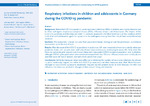Respiratory infections in children and adolescents in Germany during the COVID-19 pandemic
Buchholz, Udo
Lehfeld, Ann-Sophie
Tolksdorf, Kristin
Cai, Wei
Reiche, Janine
Biere, Barbara
Dürrwald, Ralf
Buda, Silke
Background: Before the COVID-19 pandemic, acute respiratory infections (ARIs) in children were mainly characterised by three pathogens: respiratory syncytial viruses (RSV), influenza viruses and rhinoviruses. The impact of the COVID-19 pandemic and the measures taken in Germany (especially until the end of 2021) on the incidence of ARI in children and adolescents aged 0 to 14 years and the pathogens causing them has not yet been comprehensively analysed.
Methods: The evaluation is based on data from population-based, virological and hospital-based surveillance instruments up to the end of 2022.
Results: After the onset of the COVID-19 pandemic in early 2020, ARI rates remained almost consistently below pre-pandemic levels until autumn 2021, with only rhinoviruses continuously continuing to cause ARI. Only when the Omicron variant became predominant in 2022, there were measurable COVID-19 rates at population level in children, although COVID-19 hospitalisation rates remained comparatively low. RSV and influenza waves were initially absent and then occurred ‘out of season’, but were more severe than usual.
Conclusions: While the measures taken were effective in inhibiting the number of respiratory infections for almost 1.5 years, moderately frequent but rather mild COVID-19 cases occurred when measures were lifted. When Omicron emerged in 2022 COVID-19 became moderately frequent but led predominantly to mild illnesses. For RSV and influenza, the measures resulted in changes in their annual timing and intensity.
Files in this item

